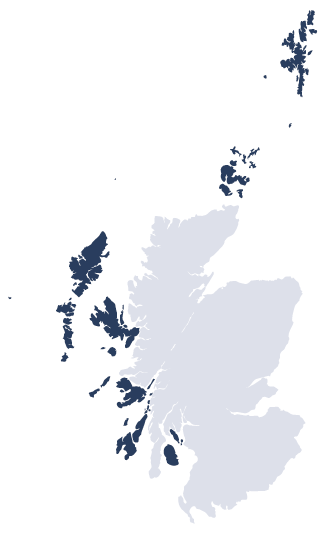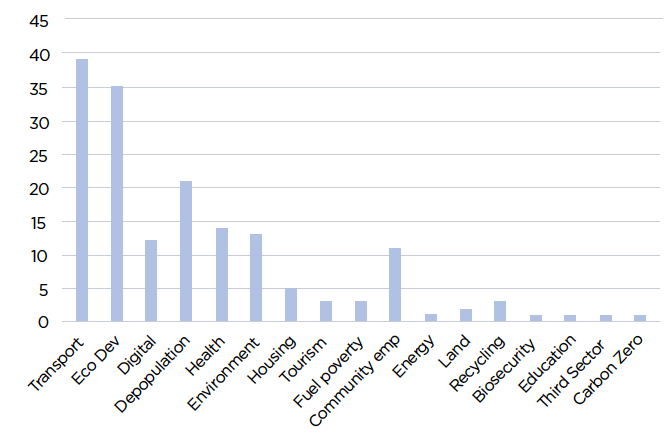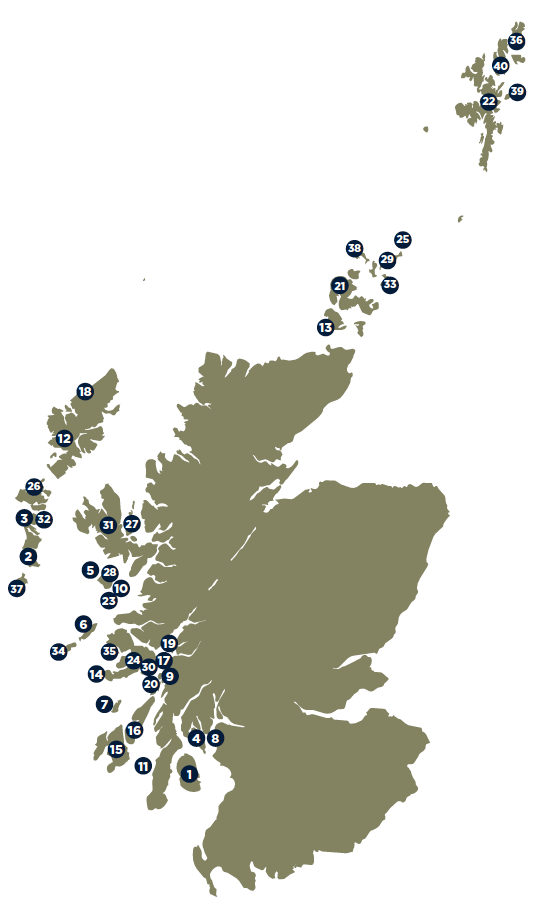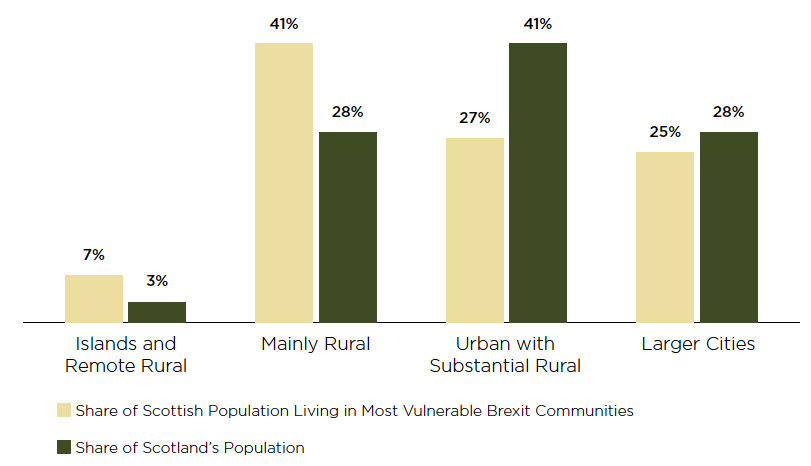The National Plan for Scotland's Islands
The National Islands Plan provides a framework for action in order to meaningfully improve outcomes for island communities. This replaces the proposed plan published in October 2019.
Introduction
Our islands are synonymous with Scotland and the nation we are. In particular, they help define how international audiences see Scotland and contribute hugely to our national identity while also preserving and promoting strong local identities. Island people on the 93 inhabited islands in Scotland,[1] - whether by birth or choice – are key to this. Islanders enjoy a strong sense of community, freedom and safety that contributes positively to living on islands in Scotland. Add to that their important economic role, their spectacular natural environment and rich cultural heritage, and you can see why people from all around the world visit and have a special affection for Scotland’s islands.
Islands and island communities in Scotland are not only resilient, but also often innovative. Whether it is in the field of community-based solutions in estate management, energy or digital connectivity, health delivery, in the arts, in culture or in language, island communities are often paving the way for ideas and solutions that can be then exported to the mainland.
While islands in Scotland are great places to live, they have been, and in some cases remain, challenging because of a number of circumstances – not least their geographical location and remoteness.
Most islands in the past experienced a much stronger population. Towards the end of the 19th century, many people from the islands emigrated around the world in search of a better life, although many did not leave through choice. The clearances have also marked the islands and island communities with some scars, still not completely healed. History tells us that islands and island communities have often felt on the periphery of public policy. Island communities have felt that decisions, which would end up affecting them, were taken by people not living on the island, who were completely detached from the reality of life away from the mainland.
The Islands (Scotland) Act 2018 and now this first five year National Islands Plan seeks to change that. It is an historic piece of place-based legislation that carries the promise of improving island governance and policy in Scotland.

Background
The genesis of the Act reflects the hard work of many people who have ensured that we reach this historic point. In June 2013, Scotland’s three island authorities – Comhairle nan Eilean Siar (the Western Isles Council), Orkney Islands Council and Shetland Islands Council launched the Our Islands Our Future Campaign,[2] with the aim of ensuring that the needs and status of island areas in Scotland were clearly recognised.
In June 2014, on conclusion of the Island Areas Ministerial Working Group’s work, the Scottish Government published the Empowering Scotland’s Island Communities prospectus.[3] This was based on three underpinning objectives:
1. Promoting the voice of island communities;
2. Harnessing island resources; and
3. Enhancing the wellbeing of island communities.
As a result, the UK Government and the three Scottish Island Councils adopted a Framework for the Islands[4] where it developed ‘island proofing’ as a principle, whereby policy and legislation must take into account islands’ circumstances, although this was not on a statutory footing. Following the Empowering Scotland’s Island Communities prospectus, the Scottish Government consulted on provisions for a future Islands Bill in 2015. A key focus of this consultation was the aspect of ‘island proofing’, with a focus on its inclusion as a principle within any future Island Bills.
This was followed by the announcement in September 2016 as part of the Programme for Government that an Islands Bill would be brought forward in the first session of the new Scottish Parliament. The Islands (Scotland) Act 2018 received Royal Assent on 6 July 2018. The first Commencement Regulations were laid on 20 September and came into force on 4 October 2018.
The Islands (Scotland) Act 2018 introduces a number of measures to underpin the Scottish Government’s objective of ensuring that there is a sustained focus across government and the public sector to meet the needs of island communities now and in the future with the aim of improving outcomes for islands communities. One of the first provisions introduced was a duty on Scottish Ministers to prepare a National Islands Plan (the Plan).
The Act sets out that ‘this Plan should set out the main objectives and strategy of Scottish Ministers in relation to improving outcomes for island communities that result from, or are contributed to by, the carrying out of functions of a public nature’.[5]
The National Islands Plan
The Plan sets a direction of travel for the Scottish Government and provides a framework for action in order to meaningfully improve outcomes for island communities. Development of the Plan has been guided by the legislation, by the experience and expertise of partner agencies and is informed by wider Scottish Government policy and strategy. But crucially, it has been shaped by what people told us was important to them.
As required by the Act, it includes proposals in relation to:
- increasing population levels
- improving and promoting sustainable economic development
- improving and promoting environmental wellbeing
- improving and promoting health and wellbeing
- improving and promoting community empowerment
- improving transport services
- improving digital connectivity
- reducing fuel poverty
- ensuring effective management of the Scottish Crown Estate
- enhancing biosecurity
Reflecting feedback from the consultation that we carried out between April and July 2019, the Plan also includes other issues that are important to our island communities: housing, climate change, energy, education and our cultural heritage.
The Plan has a duration of five years with a requirement for annual reports on progress and a review at the end of the five-year period. In accordance with the Islands (Scotland) Act 2018, we have started to develop appropriate quantitative and qualitative measures and indicators to allow us to evaluate progress against the 13 Strategic Objectives and the short, medium and long-term aims provided for in the Plan. Those indicators will be underpinned by the National Performance Framework (NPF) and Sustainable Development Goals (SDGs).
The next step will be to develop an Implementation Route Map detailing these actions, measures and indicators.
The Plan is not the only document that deals with island issues, but it is a means of focusing on islands and of considering the opportunities and challenges in the round, drawing in relevant parts of Scottish Government, our partners and agencies and the wider public sector. The Plan, where relevant, also aligns with and provides a distinctive islands communities focus to existing policies and strategies that affect the lives and wellbeing of islanders. Implementing a Fair, Integrated, Green and Inclusive National Islands Plan will require strong collaboration and partnership between Scottish Government, local authorities, island communities and all other stakeholders involved – including through community planning.
Consultation Process
In order to develop the Plan, the Scottish Ministers undertook a wide consultation exercise in 2019 with island communities.[6] The approach adopted sought to make the commitment in section 4 of the Act real, and to create a National Islands Plan which truly responds “to the distinctive geographical, natural heritage and cultural characteristics (including the linguistic heritage) of each of the areas inhabited by island communities”.[7]
The consultation process was undertaken using a combined World Café and Open Space Technology methodology format that enabled participants to engage in a wide discussion about what works well on their island and what needs to be improved.[8]
These events saw the emergence of common issues that people wanted to discuss in detail, as highlighted below:

During the consultation, the Scottish Government’s Islands Team visited 40 islands and organised 61 events and meetings, which allowed them to engage face-to-face with almost 1,000 people. The live events were complemented by an online consultation where 414 participants provided their views electronically. In addition, young people were invited to attend specific events that allowed them to share their input to the development of the National Islands Plan.[9]
Islands Visited
1 Arran
2 Barra
3 Benbecula
4 Bute
5 Canna
6 Coll
7 Colonsay
8 Cumbrae
9 Easdale
10 Eigg
11 Gigha
12 Harris
13 Hoy
14 Iona
15 Islay
16 Jura
17 Kerrera
18 Lewis
19 Lismore
20 Luing
21 Mainland Orkney (Kirkwall and Stromness)
22 Mainland Shetland (Lerwick)
23 Muck
24 Mull
25 North Ronaldsay
26 North Uist
27 Raasay
28 Rum
29 Sanday
30 Seil
31 Skye
32 South Uist
33 Stronsay
34 Tiree
35 Ulva
36 Unst
37 Vatersay
38 Westray
39 Whalsay
40 Yell

Structure of the Plan
SG Strategy - The Plan outlines how objectives and strategies to improve outcomes for island communities are underpinned by four key values: fairness, integration, environmental protection (green) and inclusiveness. It then sets out 13 Strategic Objectives and the key actions of Scottish Government and its agencies to deliver these. The last two chapters outline the next steps in relation to implementation and the role the Plan can play in relation to Scotland’s global reputation.
Within the Plan, the Scottish Government recognises the importance of the Gaelic language to many island communities, and the importance of the Gaelic speaking island communities to the survival and sustainability of Gaelic in Scotland. The Plan includes commitments throughout to supporting individuals, communities and organisations in Gaelic speaking island communities in their use of Gaelic.
Throughout the Plan, we have included some examples of good community practices taking place on Scottish islands. These have been identified partly through the consultation itself and partly thanks to the support of the Scottish Island Federation and their networks. This is not an exhaustive list as there are many more examples that the Plan has not been able to capture. However, we hope that they help to provide some information about the innovation and strength already existing on Scottish islands in a wide range of sectors.
Similarly, the Plan features some examples of Scottish Government policies and initiatives, which are already underway, and which we hope will help to support the delivery of the Implementation Route Map.
Brexit
The creation of the Plan has taken place in the context of Brexit which casts a shadow of uncertainty on the application of the EU cohesion policy to Scotland. However, the Islands Act and this Plan align themselves with the spirit that has driven the EU cohesion policy over the last decades.[10] Hence, the approach and policies to rural regions in Scotland and to island communities, as envisioned in the Plan, will not change dramatically. Understandably, our island communities are already anxious about what the future holds and whilst the Scottish Government will do what it can, the continuing uncertainties over funding streams may well have implications for what can be delivered in the future.
Analysis by the Scottish Government of the areas most vulnerable to Brexit (published in September 2019), showed that many of the communities most vulnerable to Brexit are on the islands. Around half of communities in the Shetland Islands, Comhairle nan Eilean Siar, Argyll and Bute and Dumfries and Galloway are amongst the most vulnerable communities in Scotland (20% most vulnerable datazones). On Comhairle nan Eilean Siar there are nearly 14,000 people living in the most vulnerable datazones in Scotland. Likewise, on the Shetland Islands there are more than 11,000 people living in the most vulnerable datazones. The main reasons that these island communities are so at-risk are due both to long-term community issues such as depopulation and a poor balance of working age versus older age communities and poorer access to services. Also, Brexit brings specific risks such as high proportions of the island workforce being employed in Brexit sensitive industries.
Distribution of Populations in Most Vulnerable Communities

Contact
Email: info@islandsteam.scot
There is a problem
Thanks for your feedback